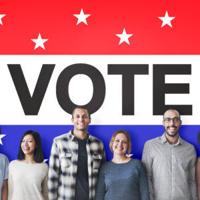We need to get more young people involved in the electoral process. Joe Biden’s decision to drop out of the presidential race paves the way for Kamala Harris and Donald Trump to work harder to close the enthusiasm gap and re-engage young people if they want to win the presidential election, something that has been a glaring shortfall in both major presidential races so far.
I run an organization that works to develop political leadership among young women, and in our most recent focus groups with college students in battleground states, we found a generation that is increasingly disillusioned with politics.
What they are looking for are candidates they can relate to and who demonstrate a genuine interest in empathizing with them. A candidate’s age doesn’t have to be a determining factor in empathy, but going the extra mile for younger people can be.
Among the Republican candidates, the endorsement of 39-year-old Senator J.D. Vance as the vice presidential candidate highlights the importance of including more young people in the electoral process. This is a bipartisan moment. His nomination represents an understanding that we need to include more young voices in the political arena, which our research shows is desperately needed.
Gen Z’s dissatisfaction stems from feeling ignored and unlistened to by their political leaders. They are wary of performative politics and crave real change and engagement. Even when it comes to voting, this generation is less likely to strictly follow traditional party lines, instead demonstrating notable independence in their political beliefs and craving candidates who can move beyond the constraints of current political dichotomies. They are wary of being asked to “pick a side.”
They want to have conversations with their peers about the issues that matter most to them without it feeling like a minefield.
In terms of picking sides, the 39-year-old running mate signals, in part, a shift toward a political future that better reflects the diversity and dynamism of younger Americans — a step in answering calls for leaders who understand Gen Z’s unique experiences and challenges.
Meanwhile, with Kamala Harris as the Democratic presidential nominee, the country must once again prove that it can break through the racial and gender barriers that define leadership. Across the country, I have seen young women of color rise up and win political elections, successfully challenging the widespread stereotype that women of color are too aggressive.
There’s a growing movement of Americans challenging these prejudices and encouraging women of color to run and win now. And when it comes to applying for the most important job in the world, that’s true. Yes, it’s true.
Women of color have ambition too. It’s not that we lack ambition; it’s that we “just don’t need to try harder.” These are arguments made by those who seek to impose on women the same biases that limit our opportunities.
When voters elected Barack Obama in 2008, many, including his wife, Michelle, thought it was impossible, but as automaker Henry Ford is often said to have said, if you asked people what they wanted, they would have said faster horses.
This country has always demonstrated what’s possible by reinventing itself and reaching for new goals, bolder than we could have ever imagined. That’s what makes America great, and it’s what breaks down our most closely guarded barriers.
From my experience working with young women, I know that Vice President Harris’ inauguration four years ago as the first African-American, South Asian and first woman to serve in this office sparked a wave of inspiration and optimism among girls of color across the country. Women of color are leading the fight for racial justice, contributing to movements like Black Lives Matter and exerting their political influence, as exemplified by Stacey Abrams’ voter mobilization efforts in Georgia.
The election also continues to be about the surveillance of women’s bodies, with young people showing they are ready to express their anger against abortion at the ballot box.
In fact, it already is. Since the Supreme Court overturned Roe v. Wade in June 2022, candidates who reject women’s right to abortion have paid a heavy price at the ballot box, and not just in states that lean one way or the other, but in states like Kansas, Kentucky, Wisconsin, Ohio, Pennsylvania, and Michigan, too. Candidates are “paying the price of Roe.”
The decision to hand over the baton to the next generation of political leaders could reignite young people’s interest in campaigning.
This calls on all candidates to take seriously the power of Gen Z at the ballot box. Their vote cannot be taken for granted. At this point in the campaign, their vote will undoubtedly be at stake and potentially decisive.


